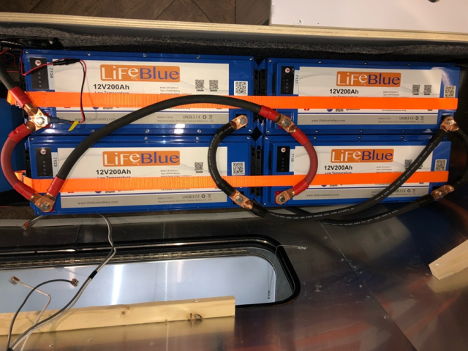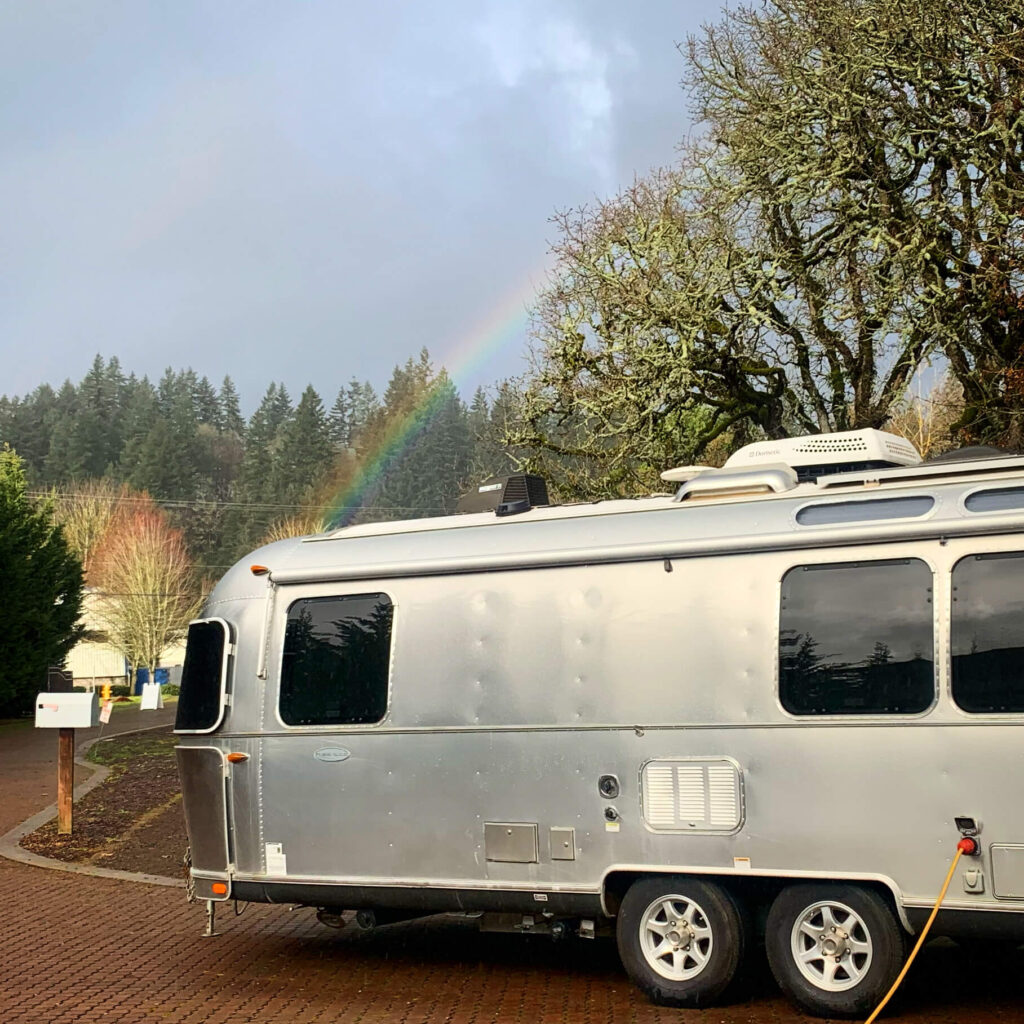When embarking on the open road with your RV, the power behind your solar system is not just a component of your journey—it’s the heartbeat. The choice between cylindrical and prismatic lithium cells can significantly impact your RV’s energy efficiency, space utilization, and overall comfort. In the realm of RV lithium power systems, two main types of LiFePO4 cells emerge as front-runners: cylindrical and prismatic.
Battle Born, a leader in the industry, opts for cylindrical cells, known for their versatility and ease of installation due to their shape, allowing for orientation in any direction. On the other hand, LiFeBlue, another renowned name, champions prismatic cells, which are recognized for their robust energy storage capabilities, albeit with a specific requirement: the terminals must face upwards during installation.
Understanding these differences is crucial for every RV owner looking to maximize their solar system’s potential. This guide is designed to provide you with a clear, engaging, and informative overview, helping you navigate the complex landscape of lithium cells. Whether you’re a seasoned traveler or new to the RV lifestyle, join us as we delve into the intricacies of cylindrical versus prismatic lithium cells and discover the best fit for your RV’s solar system.
Understanding Cylindrical and Prismatic Lithium Cells
In the heart of every RV’s solar power system lie lithium batteries, pivotal for storing the sun’s energy to power your adventures. Yet, not all lithium batteries are created equal. At the core, these batteries consist of either cylindrical or prismatic cells, each bringing distinct features and benefits to the table.
Cylindrical Lithium Cells: The Traditional Choice
Cylindrical lithium cells, such as those used by Battle Born batteries, are characterized by their long, tubular shape. This classic form factor is not just by chance; it’s a design that has been refined over decades, initially gaining popularity in consumer electronics before making its way into more robust applications like RV solar systems. Typically, these cells come in standardized sizes like 18650 (18mm by 65mm) or 26650 (26mm by 65mm), and thanks to their shape, they can be installed in any orientation, offering flexibility in battery pack design and mounting.
However, the cylindrical shape does come with its set of challenges. These cells require numerous interconnections within the battery pack, increasing the complexity of assembly and potential points of failure. Moreover, although cylindrical cells have historically had higher manufacturing costs, advancements and economies of scale have started to narrow this cost gap.
Prismatic Lithium Cells: The Modern Contender
Prismatic lithium cells, utilized by brands such as LiFeBlue, deviate from the cylindrical norm with their flat, rectangular shape. This design enables more efficient use of space and easier stacking in battery packs, making them particularly suited for applications where space is at a premium – a common scenario in RV solar systems.
Unlike their cylindrical counterparts, prismatic cells generally allow for larger cell sizes, meaning fewer cells and connections are necessary for a comparable energy capacity. This reduction in the number of connections can lead to a more reliable battery pack with potentially lower maintenance requirements. Yet, it’s essential to note that prismatic cells must be installed with their terminals facing upwards to ensure optimal performance and safety.
From a manufacturing standpoint, prismatic cells can be more straightforward to produce, especially in larger sizes. They are often found in two main chemistries: a paste-like substance used in batteries like the VE Smart LiFePO4 or a pouch cell format typical in LiFeBlue designs. These formats contribute to the prismatic cell’s reputation for efficiency and reliability in energy storage.
Both cylindrical and prismatic lithium cells have carved out their niches in the world of RV solar systems. The choice between them depends on a myriad of factors, including space constraints, energy needs, and individual preferences for maintenance and reliability. Understanding these basic differences sets the stage for a deeper dive into how these cell types perform in real-world RV applications, ensuring that you, the RV owner, are equipped to make the best decision for your solar power needs.
Pros and Cons in RV Solar Systems
Choosing between cylindrical and prismatic lithium cells for your RV solar system involves weighing various factors. Each type brings unique advantages and challenges that can significantly impact your journey and energy usage. Let’s explore these in detail to better understand which cell might be the best fit for your RV solar system needs.
Cylindrical Lithium Cells: Advantages and Disadvantages
Cylindrical lithium cells have stood the test of time, offering reliable performance across numerous applications. Their round shape contributes to efficient thermal management, an essential factor in prolonging battery life. Furthermore, cylindrical cells are capable of providing high discharge rates, which, while often unnecessary for typical RV applications that seldom exceed a 1C discharge rate, can be beneficial in scenarios requiring short bursts of power.
However, the cylindrical design is not without its drawbacks. The higher number of interconnections between individual cells increases the complexity and potential points of failure within the battery pack. This complexity can translate to more maintenance and higher long-term costs. The increased number of components in cylindrical packs, like those used by Relion and Battleborn, can still pose challenges in terms of reliability and repairability.
Prismatic Lithium Cells: Advantages and Disadvantages
On the other hand, prismatic lithium cells, favored by brands such as LiFeBlue, offer a more streamlined approach to energy storage. Their rectangular shape allows for more efficient packing and utilization of space within the battery, which is a critical advantage in the confined quarters of an RV. Additionally, with fewer cells needed to achieve the same capacity as cylindrical cells, prismatic batteries typically have fewer internal connections, leading to a lower potential for failure and maintenance.
One of the most significant advantages of prismatic cells is their ability to deliver large capacities, making them suitable for extended off-grid living or energy-intensive applications. This larger capacity, coupled with fewer connections, can result in a more reliable system with potentially greater longevity.
However, prismatic cells are not without their limitations. They require a specific mounting orientation — with terminals facing upwards — to ensure proper operation and safety. This requirement may limit installation options in some RV configurations. Moreover, while they may have a higher initial efficiency in production and energy storage, prismatic cells can be more expensive to replace if damaged, though advancements in technology and the development of modular designs are helping to reduce these costs.
Overall, the choice between cylindrical and prismatic lithium cells for your RV solar system depends on a variety of factors, including space availability, energy requirements, budget, and personal preferences regarding maintenance and durability. Cylindrical cells offer robustness and high discharge rates, but come with complexities related to their numerous interconnections. Prismatic cells, while typically more straightforward and space-efficient, may have higher upfront costs and require careful installation. Understanding these pros and cons is essential in selecting the right lithium cell type for your RV’s solar system, ensuring a balance between efficiency, reliability, and cost.
AM Solar’s Expertise and Experience
As a leader in the solar products and services industry, especially tailored for van and RV systems, AM Solar stands out through our comprehensive understanding and hands-on experience with both cylindrical and prismatic lithium cells. Our commitment is not just to provide products, but to deliver solutions that enhance your RV lifestyle.
Why Trust AM Solar?
At AM Solar, we pride ourselves on our deep-rooted knowledge and extensive background in the realm of RV solar power systems. Our team of experts is not just well-versed in the technical aspects of lithium batteries, but also deeply understands the unique needs and challenges faced by RV owners. This dual expertise enables us to recommend the most suitable battery types and solar solutions, tailored to the specific requirements of each customer.
Over the years, we’ve observed the evolution of lithium battery technology and its application within the RV sector. Our experience encompasses a wide range of installations, from compact vans requiring modest power solutions to luxurious RVs outfitted for extensive, off-grid living. This variety has allowed us to witness firsthand the performance, durability, and reliability of cylindrical and prismatic cells under different conditions and uses.
AM Solar’s Preference: A Practical Perspective
Based on our extensive experience, we have observed that cylindrical cells, such as those found in Battle Born batteries, are exceptionally versatile and can be a great fit for many RV setups, particularly when space is not a stringent constraint, and when the system’s design calls for flexibility in battery orientation. The adaptability of cylindrical cells makes them suitable for various installation configurations, which is particularly beneficial in custom or space-constrained RV setups.
Conversely, we’ve also seen the practical advantages of prismatic cells, especially in terms of space efficiency and energy density. Brands like LiFeBlue have harnessed these advantages to produce batteries that fit neatly into more structured spaces, providing ample power without occupying excessive room. For larger RVs or those with specific spatial challenges, prismatic lithium cells can offer a compelling solution, balancing power needs with spatial constraints.
In our projects, we consider factors such as the RV’s layout, the owner’s energy needs, travel habits, and budget. This holistic approach ensures that the recommended battery type not only fits physically, but also aligns with the RV owner’s lifestyle and energy consumption patterns.
At AM Solar, our approach goes beyond just selling products; we focus on providing solutions that fit our clients’ unique needs and lifestyles. Whether your journey leads you to choose cylindrical or prismatic lithium cells, our team is here to guide you through the selection process with expert advice and personalized recommendations. By leveraging our vast experience and understanding of RV solar systems, AM Solar ensures that you make an informed decision, empowering your adventures with the right energy solutions.
Choosing the Right Lithium Cells for Your RV Solar System
Navigating through the myriad of options for your RV’s solar system can be daunting. However, understanding the nuances between cylindrical and prismatic lithium cells can lead to an informed decision that aligns with your lifestyle and energy needs. Here’s how you can determine which lithium cell type is the right fit for your RV solar system.
Assess Your Space and Power Requirements
The first step in choosing between cylindrical and prismatic lithium cells is to assess the physical space available in your RV for the battery system. Prismatic cells, with their flat, rectangular shape, are often more space-efficient and might be the better option if your RV has limited space. Their compact design allows for a more straightforward, efficient packing solution, providing higher energy density without occupying too much room.
On the other hand, if your RV has more flexible space options, cylindrical cells might serve you well. Their versatility in installation orientation can be a significant advantage, allowing for more creative configurations that fit into irregular spaces.
Consider Your Energy Needs and Usage Patterns
Your travel habits and energy usage significantly influence the type of lithium cells best suited for your RV. If your adventures involve extensive off-grid time or high-energy activities, you may require a battery with a large capacity and longer cycle life. In such cases, prismatic cells, known for their higher capacity and efficiency, might be the preferable choice.
However, if your trips are shorter or you use your RV intermittently, with less intense energy demands, cylindrical cells can be quite adequate. They offer reliable power and are capable of handling typical energy loads, making them a cost-effective solution for casual or seasonal RVers.
Evaluate Long-Term Costs and Maintenance
Understanding the long-term costs and maintenance requirements is crucial when selecting your RV’s lithium cells. Prismatic cells generally have fewer internal connections, which can mean a lower likelihood of failure and potentially lower maintenance costs. However, if a prismatic cell does require replacement, it can be more expensive due to its size and construction.
Cylindrical cells, while possibly requiring more maintenance due to their numerous connections, can be less costly to replace individually. This could be a deciding factor if you prefer a battery system that’s easier and cheaper to repair, even if it might require more frequent check-ups.
Reflect on Installation and Safety
Safety and ease of installation are paramount when integrating a new battery system into your RV. Prismatic cells typically require specific installation orientations and may need additional supports due to their shape and weight. Ensure that your RV can accommodate these requirements without compromising safety or usability.
Cylindrical cells are generally more forgiving in terms of installation orientation, but their design might require more complex mounting structures to hold numerous individual cells securely in place. It’s essential to consider the complexity and cost of installation when choosing between cell types.
The decision between cylindrical and prismatic lithium cells for your RV solar system is not one to be taken lightly. By considering your space availability, energy needs, budget, and maintenance willingness, you can select the cell type that best suits your RV lifestyle. Remember, the goal is not just to choose a battery, but to ensure a reliable and efficient energy system that supports your adventures. AM Solar is here to help guide you through this decision process, ensuring that your RV is powered effectively and safely, no matter where your travels take you.
How AM Solar Can Help
Making the right decision for your RV’s lithium battery needs is crucial, but you’re not alone in this journey. AM Solar, with years of dedicated service in the RV solar system industry, is your trusted partner, ready to guide you through every step of the process.
Tailored Solutions for Every RVer
At AM Solar, we understand that every RVer has unique needs and challenges. Whether you’re a weekend trip RVer or a full-time off-grid enthusiast, our team of experts will work with you to design a solar system that fits your lifestyle. By assessing your energy needs, space constraints, and travel habits, we can recommend the most suitable combination of lithium cells and solar products for your RV.
Here are some key lithium battery products to explore:
- LiFeBlue IP67 LiFEPO4 12V Drop-In Battery
- LiFeBlue LiFePO4 12V Drop-In Battery
- Victron LiFePO4 Batteries 12.8V
Expert Installation and Support
Choosing the right lithium cells is just the beginning. Proper installation and setup are critical to ensure your solar system’s efficiency and longevity. Our certified technicians specialize in RV solar system installations, ensuring that your system is installed correctly and safely. We provide comprehensive support throughout the installation process, from initial design to final testing, ensuring that your system performs at its best.
Moreover, our support doesn’t end once the installation is complete. AM Solar offers ongoing customer service and maintenance advice, helping you keep your system in top condition for years to come.
Educational Resources and Community
At AM Solar, we believe in empowering our customers through education. Our website and blog are filled with resources, from installation guides to energy management tips, designed to help you understand and optimize your RV solar system. By sharing our knowledge and experience, we aim to build a community of informed and confident RVers.
Additionally, we understand the value of real-life experiences and customer feedback. That’s why we encourage our clients to share their stories and learn from the diverse experiences of others in the AM Solar community. Whether through customer testimonials or social media, we provide platforms for RV owners to connect and exchange valuable insights.
Your journey to a more sustainable and independent RV lifestyle begins with the right choices — and AM Solar is here to help you make those choices with confidence. From selecting the optimal lithium cells to installing and maintaining your RV solar system, our team is dedicated to providing the expertise and support you need. We invite you to reach out to us, explore our offerings, and take the first step towards a more efficient and reliable RV solar experience. With AM Solar, you’re not just choosing a service provider; you’re choosing a partner in your RV adventure.




